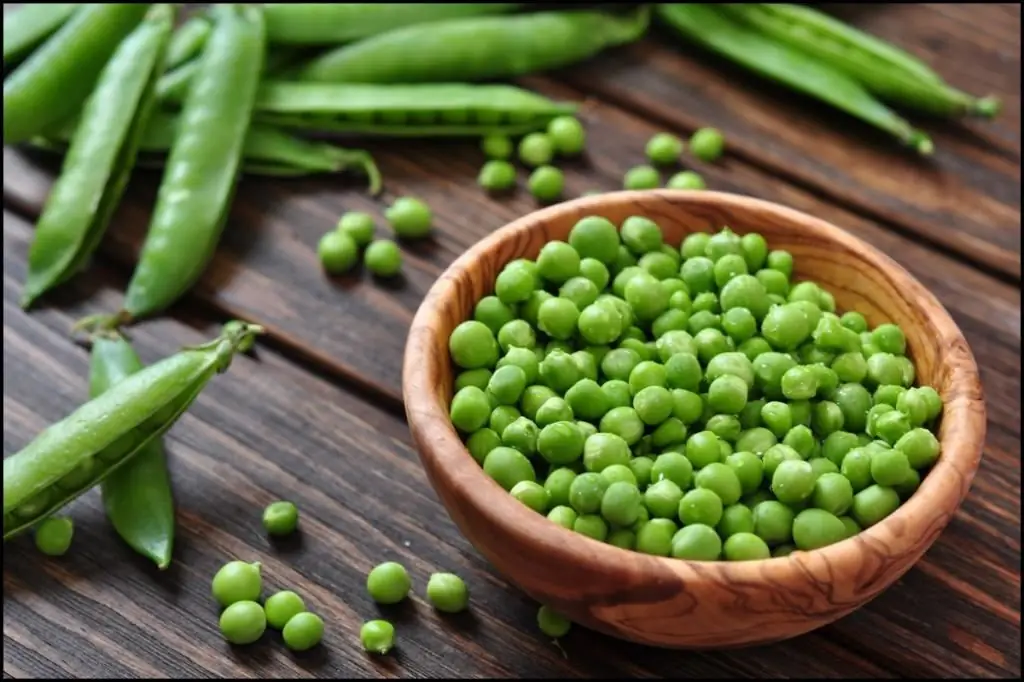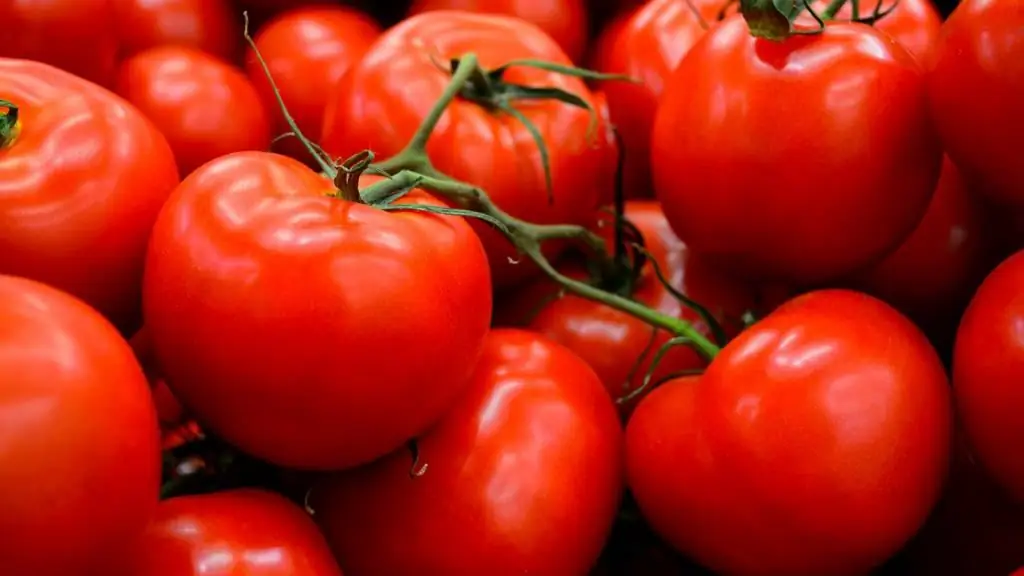2026 Author: Isabella Gilson | [email protected]. Last modified: 2025-01-23 12:50:30
From childhood, we are taught to prefer fruits and vegetables, as they contain a huge amount of nutrients necessary for growth. Vitamins, minerals and many elements in the composition contribute to the normalization of the work of all systems of the human body. A lot of nutrients are contained in the tomato. The chemical composition of a red vegetable is represented by a huge number of different elements, ranging from proteins, fats and carbohydrates to acids, vitamins and minerals. Read more about what is contained in fragrant tomatoes with a sweet and sour taste, how they are useful and whether they can be harmful, in this article.
Chemical composition

In 100 g of tomato, approximately 92 g is water. Also, the chemical composition of a fresh tomato is represented by the following substances:
- From 0.5 to 1.1 g of proteins, including essential and non-essentialamino acids.
- From 0.1 to 0.3 g pectins.
- About 0.2g fat. Tomato seeds contain 17-29g of oil.
- 0.1 to 0.2 g of hemicellulose.
- 0.5 to 0.9 g fiber.
- 5 g of carbohydrates, including mono- and disaccharides.
- From 0.2 to 0.9 g of organic acids, including citric, oxalic, malic, tartaric and succinic.
Vitamins in tomatoes

The chemical composition of a tomato is distinguished by a large number of vitamins, each of which is necessary for the body for the stable operation of a particular system. Most of all it contains ascorbic acid. Vitamin C has a beneficial effect on connective and bone tissues, is an excellent antioxidant and takes part in metabolic processes. A little less in the composition of choline. This is vitamin B4, known to mankind as the neurotransmitter acetylcholine, into which it is synthesized when it enters the body. This substance, in turn, has a beneficial effect on the nervous system, and is also involved in carbohydrate metabolism. The neurotransmitter acetylcholine regulates the level of insulin in the body and has a beneficial effect on the functioning of the liver, helping its cells to start regeneration processes. Finally, vitamin B4 protects the myocardium from damage.
A lot of the chemical composition of tomato and niacin. More commonly known as vitamin B3, it is involved in carbohydrate, fat and protein metabolism in cells. Niacin is important for tissue respiration, and is also valued as a regulator of oxidativerecovery processes. It is directly involved in the work of the digestive system, helping to break down food, synthesizes sex hormones and even helps to suppress the growth of a malignant neoplasm.
Tocopherol has a beneficial effect on the circulatory system, promotes tissue regeneration and is an excellent antioxidant. In general, this is a beauty vitamin, as it has a positive effect on the condition of the skin, preventing the appearance of senile pigmentation and participating in the formation of collagen and elastic fibers. Also, vitamin E is useful during pregnancy, because it promotes the development of the placenta. And pyridoxine is one of the main substances involved in metabolism. Vitamin B6 has a positive effect on the central and peripheral nervous system, and also prevents the development of cancer.
Thiamin regulates the transmission of nerve impulses and maintains water-s alt balance. In addition, vitamin B1 is involved in the processes of hematopoiesis and digestion. Riboflavin, or vitamin B2, is needed for the formation of red blood cells and normal thyroid function, and beta-carotene is the strongest antioxidant that positively affects the quality of hair and skin.
Folic acid in the chemical composition of tomatoes is necessary for normal cell division, development of all organs and tissues. Vitamin K1 promotes the elimination of toxins and other harmful substances from the body, increasing life expectancy, and biotin plays an important role in metabolic processes, is involved in the biosynthesis of hormones and is necessary for the synthesis of beneficial microfloraintestines.
Macronutrients rich in tomatoes

Macronutrients are another important part of the chemical composition of a tomato. The nutritional value of the product is determined, among other things, by such important substances:
- Sodium - is a catalyst for chemical processes, maintains water and alkaline balance in the body.
- Potassium - maintains acid-base balance.
- Silicon - is involved in the formation of epithelial and connective tissues.
- Chlorine - necessary for the formation of gastric juice.
- Sulfur - takes part in the formation of protein, is a component of amino acids.
- Phosphorus - part of the bones and tooth enamel.
- Calcium is a building material for teeth and skeleton, is involved in blood clotting and hormone secretion.
- Magnesium - regulates the transmission of nerve impulses, is important for the stable operation of the musculoskeletal system.
Trace elements in tomato

Speaking about the energy value and chemical composition of tomatoes, one cannot fail to mention trace elements. Among them:
- Selenium - participates in redox processes and is an integral element of more than 30 vital biologically active compounds of the body.
- Iodine - part of the thyroid hormones.
- Vanadium - is involved in the processes of hematopoiesis and respiration, is important for the formation of teeth and bones.
- Nickel - participates in enzymaticprocesses.
- Iron is important for breathing.
- Molybdenum is an important component of tissue respiration, supports the immune system.
- Chromium - takes part in the metabolism of proteins, carbohydrates and lipids.
- Cob alt - participates in the processes of hematopoiesis, helps the liver and nervous system.
- Fluoride - found in bones and tooth enamel.
- Manganese - supports the work of the gonads and the process of hematopoiesis.
- Beryllium is important for metabolic processes.
- Aluminum - ensures the establishment of bonds with nitrogen and oxygen, actively participates in regeneration processes.
- Lithium - has a beneficial effect on the nervous system and neurochemical processes in the brain.
- Boron - found in human blood, as well as in bone and muscle tissue.
- Barium - regulates smooth muscle contractions.
- Copper - involved in protein metabolism.
- Zinc - involved in the synthesis of hormones, necessary for the male reproductive and reproductive systems.
- Rubidium - stimulates the nervous and cardiovascular system.
- Germanium - delivers oxygen to tissues, protects the body from foreign substances, has a beneficial effect on the digestive system and delays the development of malignant neoplasms.
Essential amino acids

The chemical composition of tomatoes is also represented by amino acids. Almost all of them (replaceable and irreplaceable) are part of proteins, participate in their formation, as well as in various biochemical processes. Essentials include:
- phenylalanine;
- lysine;
- leucine;
- valine;
- isoleucine;
- threonine;
- histidine;
- tryptophan;
- methionine.
Essential amino acids
This list includes the following substances:
- proline;
- glutamic acid;
- cystine;
- aspartic acid;
- glycine;
- serine;
- alanine;
- arginine;
- tyrosine.
Useful properties of tomatoes for humans

If you study the chemical composition of tomatoes, the nutritional value of a vegetable for the body becomes fully understood. Regular (but in moderation!) Eating tomatoes has an immunostimulating, tonic, anti-inflammatory, antioxidant, antibacterial and diuretic effect on the body. The vegetable helps to reduce nervous excitability, serves as a stimulant of brain activity, and has a positive effect on the functioning of the gastrointestinal tract, liver and kidneys. Supports the cardiovascular system, monitors the level of "bad" cholesterol in the blood. In general, not a vegetable, but a real storehouse of nutrients.
Can a tomato hurt?
Yes, if you eat a vegetable in large quantities. You should not overeat tomatoes, in which case you can not only not wait for positive results, but also cause a negative effect. It is expressed by an increase in the likelihood of gallbladder spasms and even the formation of kidney stones. Also, with extreme caution, you need to use tomatoes for people withprone to allergic reactions and suffering from gallstone disease.
Other important information

It's nice to know that there are only 18-20 kcal in 100 g of tomatoes. Therefore, they are popular in diet food. Especially cute cherry tomatoes. The chemical composition of the "kids" is represented by the same useful substances as in the case of large varieties. Various salads and vegetable sauces are prepared with them, which are tasty and he althy both for the body and for the figure. However, in order to retain nutrients, it is not recommended to subject the tomatoes to heat treatment. It is better to eat them fresh.
Special attention should be paid to the choice of tomatoes. Since in most cases they are processed with chemicals, it is better not to buy tomatoes from strangers. It is advisable to find a conscientious seller whose vegetables do not make you doubt the quality.
Today you can find interesting collection varieties. Of course, many gardeners are wondering if it is worth buying them? Of course, the collection samples of tomatoes were studied in terms of chemical composition, and the results are more than pleasant - they have the same (if not better) properties and qualities as ordinary varieties. Moreover, they boast better disease and temperature resistance. So collectible varieties deserve no less attention.
Recommended:
Cod fish: benefits and harms, calories, composition of vitamins and minerals, nutritional value and chemical composition. How to cook delicious cod

This article will tell you about what is included in the chemical composition of cod, what benefits it brings to human he alth, and also in what cases it should not be consumed. There will also be presented several recipes for cooking cod in the oven, in a pan, in the form of fish soup, etc
Meat: nutritional value, chemical composition, biological value, energy value, characteristic

Humanity has been eating meat since antiquity. Anthropologists believe that meat, whose nutritional value is invaluable, played a huge role in the development of the human brain
Rice: chemical composition, nutritional value, he alth benefits and harms

Is rice a he althy crop? What are its contraindications? Which type of product has more positive properties? After reading this article, you can get answers to these questions, as well as get acquainted with the chemical composition of this product
An egg is The chemical composition of chicken eggs, the benefits and harms, calories and nutritional value

What is an egg. The chemical composition of the product and its benefits to the human body. How to choose an egg. Energy value and standard according to GOST. Damage to eggs. Who is forbidden to eat eggs. The composition of the yolk and protein
Peas: chemical composition, nutritional value, vitamins, benefits and harms

Peas are the most ancient member of the legume family. People have known about this culture since ancient times. The places of origin of peas are considered to be India, Ancient China, as well as some countries of the Mediterranean. Throughout Europe and the New World, it spread precisely from Asian lands. The Chinese have long revered peas as a symbol of fertility and material we alth

